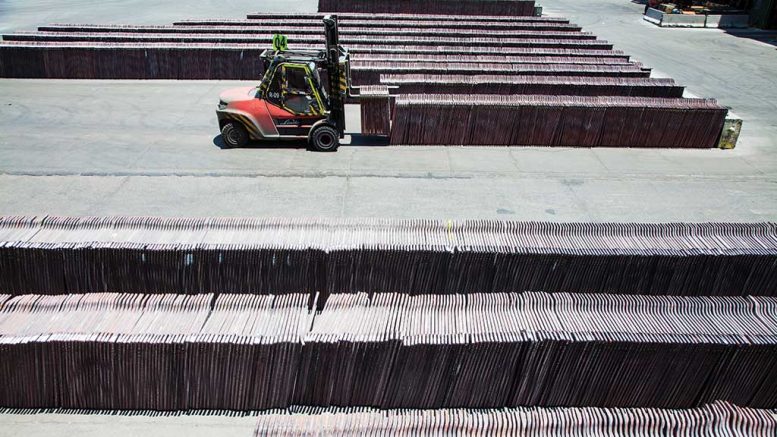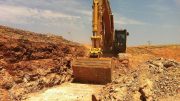Rory Johnston is a commodity economist covering energy, metals and agriculture markets in Scotiabank’s economics department. He is the author of the “Scotiabank Commodity Price Index,” a monthly report that assesses developments affecting the prices of Canada’s major export commodities, as well as a contributor to Scotiabank’s “Global Outlook,” the department’s flagship quarterly forecast publication. Johnston holds a graduate degree from the University of Toronto’s Munk School of Global Affairs and a bachelor’s degree in political studies from Queen’s University. He recently spoke to The Northern Miner about his outlook for next year.
The Northern Miner: Global economic growth has been fairly strong over the last year. How this will impact base metals and bulks in the next few years?
Rory Johnston: Industrial metals and in particular base metals are seeing support from an accelerating global economy and increased manufacturing activity. You have all the major advanced and emerging market economies growing and accelerating for the first time since the global financial crisis, and it’s putting a lot of tailwinds behind the base metals complex.
TNM: That’s not as true for bulks like iron ore, however.
RJ: Yes, you can juxtapose some of the base metals’ strength against some of the weakness in the bulk commodities, like iron ore used in the steel complex. You still have an accelerating global economy, but the global steel industry is much more leveraged against Chinese real estate and construction activity, and you’re seeing a pullback — a tightening of financial conditions and a withdrawal of stimulus in China over the last 18 months — and that’s deflating some housing prices in major Chinese cities, which is lessening the incentive to build new buildings. As construction activity starts to fall off, so too does the demand for steel rebar within China. So even though base metals are seeing a lot of growth tailwinds, China more broadly will be a headwind for the bulks … slowing construction, real estate and infrastructure spending.

“Zinc has the strongest fundamentals of any of the major base metals. We see continued price gains through next year, likely peaking in early 2019.”
Rory Johnston
Commodity Economist, Scotiabank
TNM: We have also seen the Chinese government getting more serious about curbing its smog problem and introducing environmental policies to combat it. How will that affect the base metals complex?
RJ: It depends on the metal. What I call China’s “blue-sky policies” [other companies use different names] are aimed at tackling smog challenge in large eastern cities, particularly in the winter, when heating demand ramps up and coal-fired power plants kick in. The government’s policy is aimed at reducing capacity utilization of a lot of energy-intensive metal processes. One of the major ones is aluminum. We’re seeing a lot of that capacity being idled, which is a big reason why the aluminum price is rising. Roughly one-third of the cost of producing aluminum is electricity, versus other metal smelting processes where electricity isn’t as large an input, so it’s been particularly hard-hit on aluminum supply. You’re also seeing parts of aluminum’s supporting supply chain tighten (e.g., alumina and carbon anode).
You have limits on the amount of scrap metal that China is allowing to be imported into the country, and because of that, China has to import different material to replace metal contained in the scrap. More broadly, the question with the environmental policies is that you are seeing a tightening of some supply situations in China, and I think that’s primarily the case on aluminum, as well as some steel smelting. The steel price has remained relatively buoyant because a lot of China’s environmental policies have aimed at shutting down older and less efficient steel smelters in the economy, so that’s pushing up the cost curve to more sophisticated facilities.
TNM: Last year aluminum averaged 73¢ per lb. and your forecast for 2017 is 86¢ per lb., rising to 90¢ in 2019.
RJ: There are a couple of questions we’re trying to figure out on the aluminum side. How forcefully will the Chinese government enforce its environmental protection policies? In the past, enforcement has been a little lax, but this year it seems they really mean it and intend to crack down on infractions. If so, that’s a positive on the price.
The less aluminum supply out of China, the more you need to see supply outside China pick up. You have a Chinese market where there is surplus aluminum production, and you have the world outside of China with a deficit of aluminum production, so the balancing mechanism is Chinese exports. If we have less supply from China, we need aluminum smelters elsewhere to pick up the slack. So depending on how serious the supply loss is from China, we’ll need prices that incentivize ex-China production. If we have heavy supply reductions in China, I expect to see the price around US$1 per pound. If we see signs that enforcement in China is waning, I expect prices to drop back down to about 90¢ a pound.
TNM: What about copper, which last year averaged US$2.21 per lb., and which you forecast will average US$2.69 per lb. in 2017? In the first week of December copper was US$3.09 per pound.
RJ: I’ve been calling copper to come back down for a while now. Copper has been relatively overvalued for a couple of months. Prices hit a high above US$3.20 per lb. in October and that price felt a little too high. Copper prices are going to come down from where they are right now. We have copper averaging US$2.85 per lb. in 2018 and rising to US$3 per lb. in 2019. They will steadily increase thereafter and likely hit a peak price above US$3.50 per lb. by early next decade.
Over the last year there has been a little bit of fundamental support for a copper rally. We saw slightly higher demand from China, so that was a demand surprise. We also saw higher-than-expected supply disruption in many parts of the world. While we do see deficits starting to emerge over the next couple of years, on the emptying supply of new mine projects, I don’t think we’re there quite yet. So while it’s possible that the copper price can be bid up higher now in anticipation of that future shortage, there’s no need to see those higher prices today.
TNM: Benchmark copper on the LME closed down 4.2% at US$6,542 a tonne on Dec. 5, which apparently was the worst drop in a single session since July 2015. What was going on there?
RJ: You’ve seen high levels of speculative activity in copper contracts as a lot of funds and managed money have gone into copper contracts based on the global growth story. The challenge is that as more and more fund money went into copper contracts, they reached an all-time high on net positions, and those positions only had one way to go, and as you started to see copper price level out and dip down, people with long contracts started liquidating to take profit, and then there was an incentive to short it to catch it on the way down. The price rout was a liquidation of speculative contracts. So while a revisiting of the China growth story may have prompted that, it doesn’t really play into my view of the correction, because copper already appeared slightly overvalued, given the fundamentals and due for a move lower.
TNM: What is your view on nickel? Last year the average nickel price was US$4.36 per lb. and your forecast for nickel in 2017 is an average of US$4.64 per lb., rising to US$5 per lb. in 2018.
RJ: It’s a market that is starting to see real deficits after a decade of surplus production. So that is definitely favourable for nickel going forward and is likely to keep momentum on the upside. The unfortunate reality is that you have a very large pile of inventory that had been built up during the period of surplus production. On major commodity exchanges — COMEX, the LME and the Shanghai Futures Exchange — you have upwards of 90 days of demand worth of nickel on those exchanges versus nine to 11 days of demand for copper, zinc and aluminum. So you do have a significant inventory overhang with nickel that you don’t see in the rest of the base metals.
While we do see upward gains for the next little while, we’re forecasting a 50¢ gain per lb. per year going forward. You’re really only going to be able to see prices higher than that once we start drawing out the inventory overhang, and it’s probably larger than what we see in official statistics because a lot of the inventory is likely held off exchange, where data is scarce. We see nickel prices moving from US$5 per lb. in 2018 to US$6.50 per lb. in 2021, so just mild upward gains.
TNM: It’s interesting because nickel was around US$8 per lb. in 2014–2015.
RJ: That was mainly on news that Indonesia was banning exports of unprocessed nickel ore to build up a local processing industry. They wanted to capture that ore in-country to provide cheaper feedstock for the processing industry they were developing. Now a lot of those processing facilities have been built, so we’re expecting more nickel [pig iron] from Indonesia. You’ve also seen a loosening of those unprocessed export restrictions, so likely the export from Indonesia of both processed and unprocessed nickel ore will have a negative price impact.

Canadian Zinc’s past-producing Prairie Creek zinc-lead-silver project in the Northwest Territories. Credit: Canadian Zinc.
TNM: Last year zinc averaged 95¢ per lb., and you forecast US$1.27 per lb. for 2017 and U$1.50 per lb. in 2018.
RJ: Zinc has the strongest fundamentals of any of the major base metals. We see continued price gains through next year, likely peaking in early 2019. The story on zinc is one of significant supply deficits on the raw materials side as you saw a bunch of significant mines closed, Century in Australia and Lisheen in Ireland, among others. When you combine those closures with still strong demand growth and not a lot of new mines starting up because of the previously weak price environment, we have a very large deficit in zinc supply.
The shortage of zinc concentrate — the precursor material that is smelted and refined into metal — is where the tightness began, and that has become even more extreme over time, which is reflected in refiner treatment charges. Treatment charges, the prices charged by refiners to miners to refine the ore they provide, fell to US$25 per tonne in October 2017, down from over US$200 per tonne in 2015, so that’s the clearest sign of extreme tightness in the precursor supply chain.
Treatment charges are inversely related to the availability of concentrate. We have seen significant drops of finished metal inventories on the major exchanges. Concentrate tightness has worked its way into the metal market, emptying inventories and pushing zinc futures into dramatic backwardation, as consumers try to secure near-term supplies. At the beginning of 2016 zinc was at a low of 67¢ per pound. This year, we saw zinc move from a low of US$1.10 per lb. in June to about US$1.45 per lb. today. We see zinc prices in 2018 of about US$1.50 per lb., and then peaking in 2019 at US$1.60 per pound.
TNM: Moving to the bulks, iron ore [fines 62% CFR China] averaged US$58 per tonne last year and your forecast for 2017 is US$71 per tonne, dropping to US$60 per tonne next year.
RJ: Iron ore has experienced headwind from the slowdown in China’s housing sector. All major metals are coming off a decade of significant supply growth and new supply is slowing, which in the base metals means higher prices due to still-strong global demand. However, the demand picture has been flat to declining for seaborne demand for iron ore, so that means that rationalization needs to be on the supply side and prices need to drop lower. We need US$60 per tonne (fines 62% CFR in northern China). That price is low enough to keep most of the high-efficiency producers profitable (Australians and Brazilians), but are likely low enough to force lower quality and less efficient supply from China. With Chinese iron ore, the iron content is typically as low 15%, while benchmark contracts are closer to 63% iron content. Flat demand means the fundamental response needs to be on the supply side.






Be the first to comment on "Scotiabank’s Rory Johnston assesses base metal outlook"